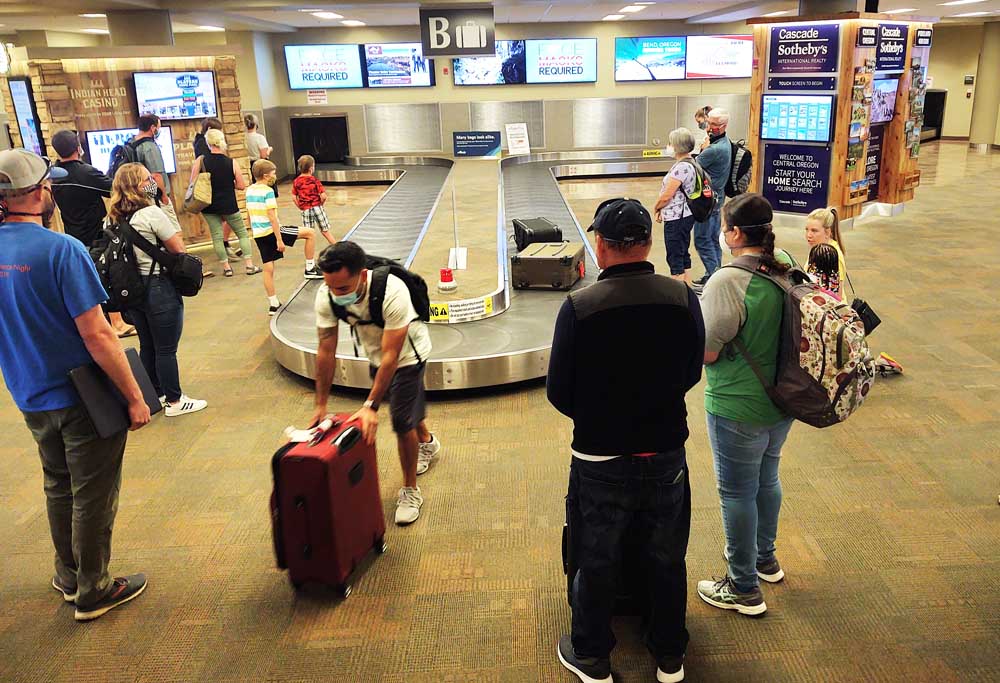Central Oregon’s Redmond Airport fares better than most
Published 4:30 am Sunday, September 27, 2020

- Passengers wait for their baggage shortly after a flight arrived to the Redmond Airport this summer.
Six months into the pandemic and the Redmond Airport, like many other regional airports, is still far from its normal capacity.
It’s staying afloat, assessing its pocketbook and figuring out its future.
The 482-parking stall lot is complete.
And the 42,000 square foot snow removal equipment complex is underway.
As a self-sufficient entity, the airport may decide to put on hold the terminal expansion that was on the books before the pandemic struck because the airport was seeing a record number of passengers.
What will happen once the pandemic is under control is anyone’s guess, said Zach Bass, Redmond Airport manager. A year ago, Sept. 20, the airport registered 44,802 enplanements in a single day, which is the metric used to count the number of passengers boarding a plane. At the height of the lockdown in Oregon in April, Redmond recorded a mere 1,863 planes boarded in a single day.
Passengers are returning, but slowly. In August, the airport registered 20,390 enplanements, according to an airport report. It’s a similar story at nearby Eugene Airport, which recorded 21,089 emplaned passengers in August, compared to 58,315 passengers in the same period the year before. That’s a 64 % decrease, according to data.
“It’s painful at this point,” Bass said. “Everything ebbs and flows. Things might not look as busy as they had been.”
Airports derive revenues from passengers, Bass said. Redmond gets $17 every time a passenger gets on a plane. Still, the largest portion of the airport’s revenues comes from parking and food concessions, Bass said. The airport is projected to lose about $2 million in parking fees since the pandemic began, he said.
The airport did not have to lay off any employees or lower hours because of $8.9 million in grants from the $2.2 trillion government aid package.
“We’re conservatively watching our budget,” Bass said. “We cut a lot of stuff out of our budget, like larger pieces of equipment, and put capital projects on hold.”
Routinely the airport makes pitches to airlines encouraging them to add or keep routes to and from Redmond. And generally, a few days of smoke or a few days of snow won’t create the kind of problem where an airline would consider pulling routes, Bass said.
“When we go out, we show these airlines the potential of the region,” Bass said. “We show them the numbers from tourism, in-migration, the K-12 enrollment. All of that shows more people are moving here. Bend was named the No. 1 telecommuting community in the region.
“We’re looking at the broader picture of the economic health of a community.”
Redmond is unique in that it’s the only commercial airport within 150 miles of either Eugene in the south or Portland in the west and even further to the northeast in Pendleton.
“Redmond has been fortunate to withstand the economic impact that has hurt so much of the United States,” said Redmond City Manager Keith Witcosky. “Redmond, and all of Central Oregon, is experiencing growth as people who live, work and own companies in more densely populated areas make decisions to move out of the chaos to a location where we are known for being business-friendly and getting things done.”
Bend was Oregon’s fastest-growing large city in 2019, and its population has grown 31% since 2010, according to the U.S. Census Bureau. Since 2017, Redmond’s population has grown by 6%.
A viable airport is important to the region’s tourism, even though a majority arrive by car, said Kevney Dugan, Visit Bend CEO. The airport provides a vital connection for people traveling in and out of Central Oregon, he said. Before the pandemic hit, the number of passengers at the airport hit 1 million and airlines were routinely adding routes.
“Losing routes or flights makes it more likely Bend residents will need to drive three hours to Portland to kick off vacations or business travel,” Dugan said.
American Airlines, one of the carriers that service Redmond, said there has been a continued decrease in demand from Redmond, but at this time it doesn’t plan on making wholesale changes to its service, said Brian Metham, American Airlines senior specialist, global communications.
Last year was the best year for growth at Redmond, and because of that, it is in the midst of planning a terminal expansion, Bass said.
“The airport is self-sufficient, self-sustaining,” Bass said. “All revenue produced by the airport must be reinvested in the airport.”








